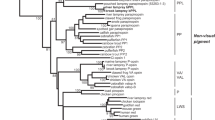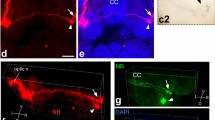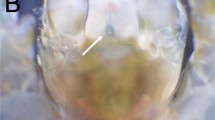Summary
Physiological findings indicate that the lizards parietal eye is a functional photoreceptor displaying a complicated pattern of slow (graded) responses during adaptational changes and opposite patterns of impulse activity in response to blue and green light. In addition to the parietal eye a pineal organ (epiphysis cerebri) is present in lizards, ultrastructurally consisting of some essentially normal and of many decomposed and degenerated outer segments. Recording by stainless steel needles inserted into theepiphysis cerebri ofLacerta sicula campestris, Acanthodactylus erythrurus andIguana iguana after removal of the parietal eye revealed photic responses differing from those of the parietal eye by being purely inhibitory in response to all light stimuli and showing an absolute intensity threshold within the photopic range (4 lm/m2) and maximum sensitivity at about 600 nm. After allowance is made for the vascular filter effect of blood in front of the epiphysis a shift of maximum sensitivity is obtained to shorter wavelengths indicating the presence of a similar photopigment in the photoreceptors of theepiphysis cerebri as in the lateral eye (λ max 570 nm).
Similar content being viewed by others
References
Ariëns Kappers, J.: The sensory innervation of the pineal organ in the lizard,Lacerta viridis, with remarks on its position in the trend of pineal phylogenetic structural and functional evolution. Z. Zellforsch.81, 581–618 (1967).
Dodt, E., and K. Echte: Dark and light adaptation in pigmented and white rat as measured by electroretinogram threshold. J. Neurophysiol.24, 427–445 (1961).
—, u. Y. Morita: Purkinje-Verschiebung, absolute Schwelle und adaptives Verhalten einzelner Elemente der intracranialen Anuren-Epiphyse. Vison Res.4, 413–421 (1964).
—, and E. Scherer: The electroretinogram of the third eye. In: Advances in electrophysiology and-pathology of the visual system. VIth ISCERG Symposium, p. 231–237. Leipzig: VEB G. Thieme 1968a.
——: Photic responses from the parietal eye of the lizardLacerta sicula campestris (De Betta). Vision Res.8, 61–72 (1968b).
Eakin, R. M.: Cytochemical and cytological studies of the parietal eye of the lizard,Sceloporus occidentalis. Z. Zellforsch.53, 449–470 (1961).
Glaser, R.: Increase in locomotor activity following shielding of the parietal eye in night lizards. Science128, 1577–1578 (1958).
Gruberg, E. R., J. E. Heath, and R. G. Northcutt: Photosensitivity of the parietal eye of the lizard,Phrynosoma cornutum. Proc. XXIV th Intern. Physiol. Congr. Washington 1908. Abstr. of Comm., p. 171.
Hamasaki, D. I.: Properties of the parietal eye of the green iguana. Vision Res.8, 591–599 (1968).
—: Spectral senstivity of the parietal eye of the green iguana. Vision Res.9, 515–523 (1969).
—, and E. Dodt: Light sensitivity of the lizardsepiphysis cerebri. Pflügers Arch.307, 152 (1969).
Langlois, J. P.: La régulation thermique chez les poikilothermes. J. Physiol. Path. gén.4, 249–256 (1902).
Lierse, W.: Die Gefäßversorgung der Epiphyse und Paraphyse bei Reptilien. Progr. Brain Res.10, 183–192 (1965).
Miller, W. H., and M. L. Wolbarsht: Neural activity in the parietal eye of a lizard. Science135, 316–317 (1962).
Morita, Y.: Entladungsmuster pinealer Neurone der Regenbogenforelle (Salmo irideus) bei Belichtung des Zwischenhirns. Pflügers Arch. ges. Physiol.289, 155–167 (1966).
—, and E. Dodt: Nervous activity of the frog'sepiphysis cerebri in relation to illumination. Experientia21, 221–222 (1965).
Oksche, A.: Survey of the development and comparative morphology of the pineal organ. Progr. Brain Res.10, 3–29 (1965).
—, u. H. Kirschstein: Unterschiedlicher elektronenmikroskopischer Feinbau der Sinneszellen im Parietalauge und im Pinealorgan (Epiphysis cerebri) der Lacertilia. Z. Zellforsch.87, 159–192 (1968).
Palenschat, D.: Beitrag zur lokomotorischen Aktivität der Blindschleiche (Anguis fragilis L.) unter besonderer Berücksichtigung des Parietalorgans. Thesis, Göttingen 1964.
Peregrin, J.: Personal Communication (1969).
Stebbins, R. C., and R. M. Eakin: The role of the “third eye” in reptilian behaviour. Amer. Museum Novitates1870, 1–40 (1958).
Stebbins, R. C., and D. C. Wilhoft: Influence of the parietal eye on activity in lizards. In R. I. Bowman (ed.): The Galapagos; Proc. of the Symp. of the Galapagos Internat. Scientific Project, pp. 258–268. University of California Press 1966.
Steyn, W.: Some epithalamic organs, the subcommissural organ, and their possible relation to vertebrate emergence on dry land. S. Afr. J. Sci.57, 283–286 (1961).
Studnička, F. K.: Die Parietalorgane. In A. Oppel: Lehrbuch der vergl. mikrosk. Anat. der Wirbelt. Part 5. Jena: G. Fischer 1905.
Wintrobe, M. M.: In: P. L. Altman and D. S. Dittmer (edit.)Biology Data Book, p. 265. Federation of American Societes for Experimental Biology, Washington, D.C., 1964.
Author information
Authors and Affiliations
Rights and permissions
About this article
Cite this article
Hamasaki, D.I., Dodt, E. Light sensitivity of the Lizard'sEpiphysis Cerebri . Pflugers Arch. 313, 19–29 (1969). https://doi.org/10.1007/BF00586325
Received:
Issue Date:
DOI: https://doi.org/10.1007/BF00586325




